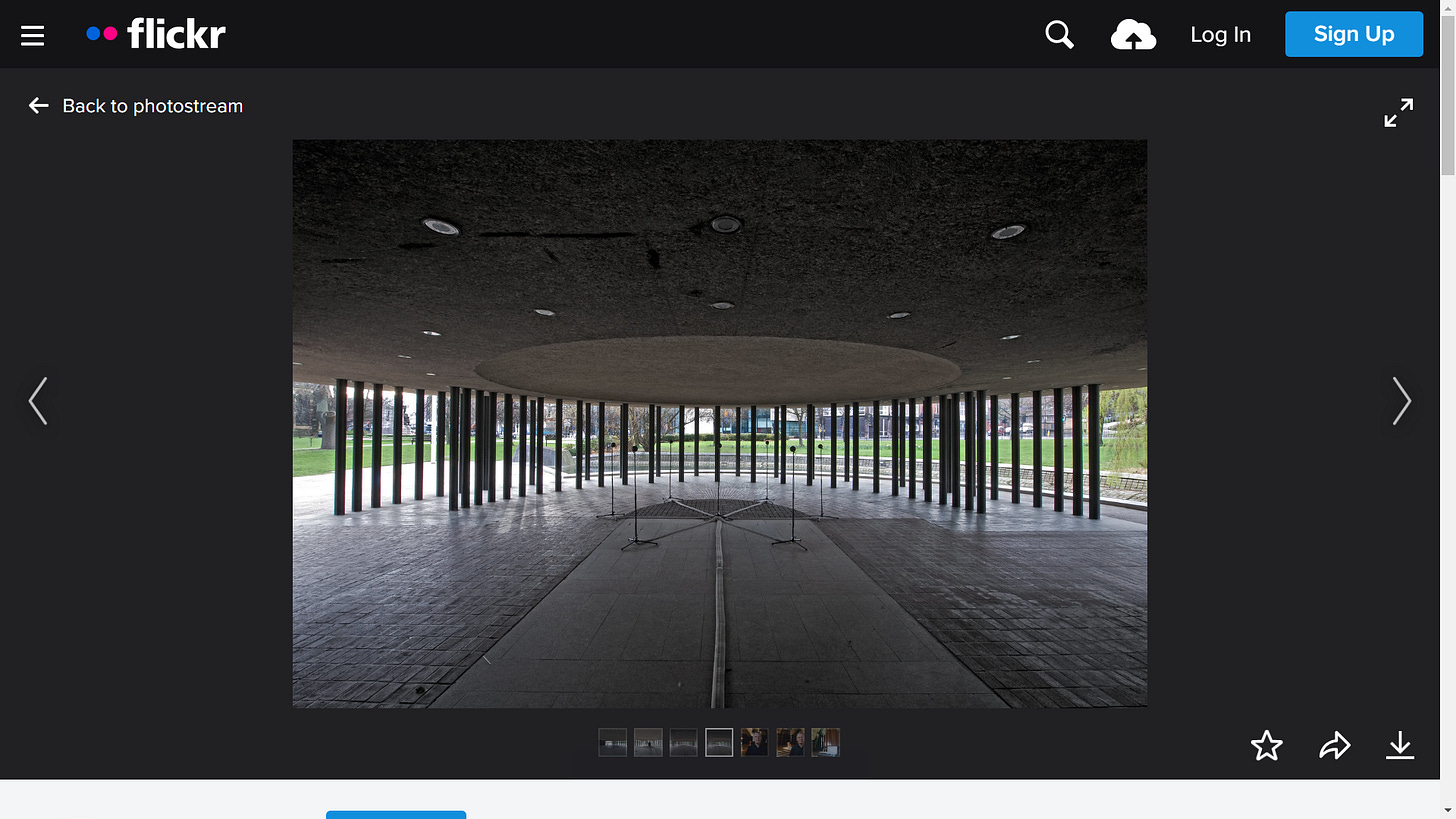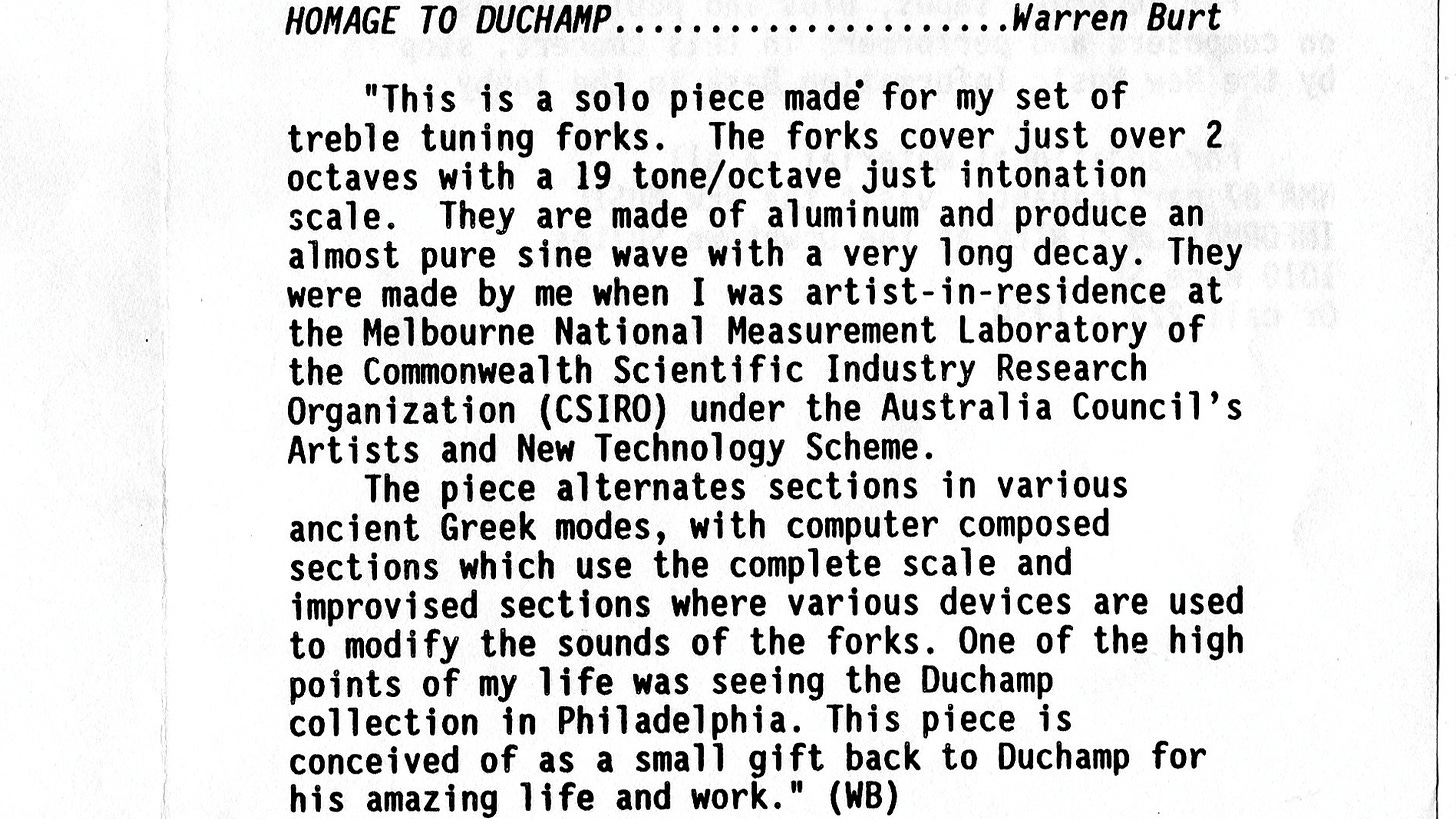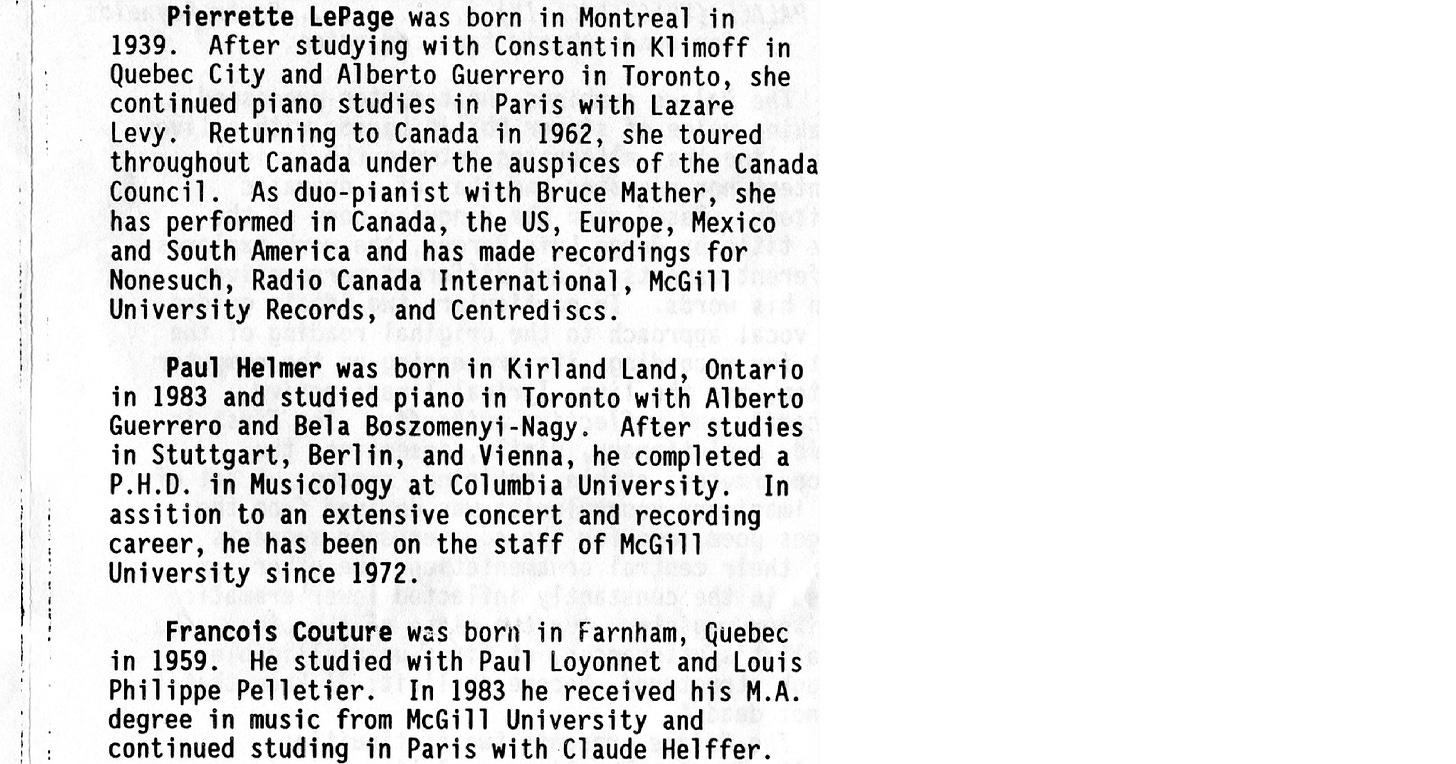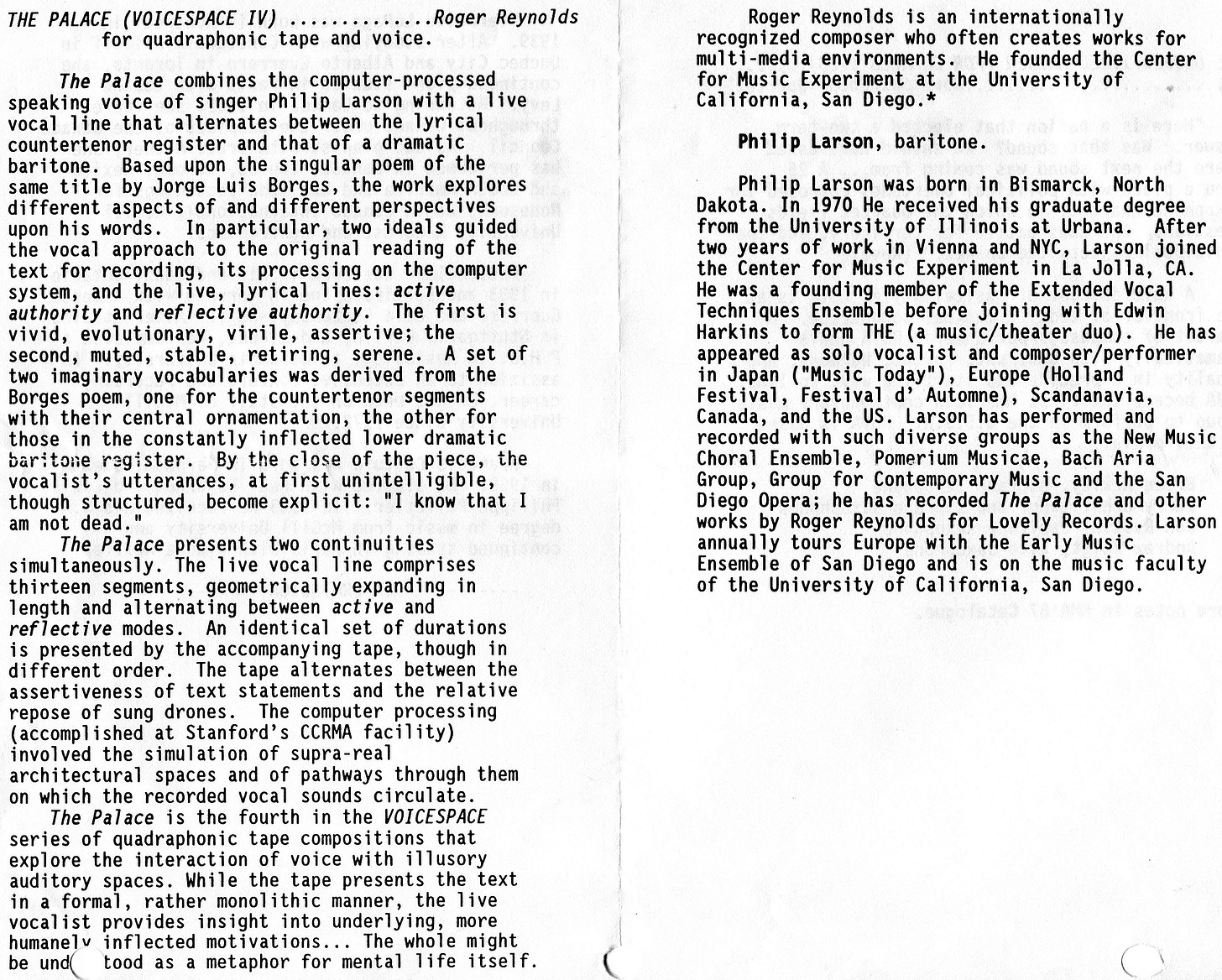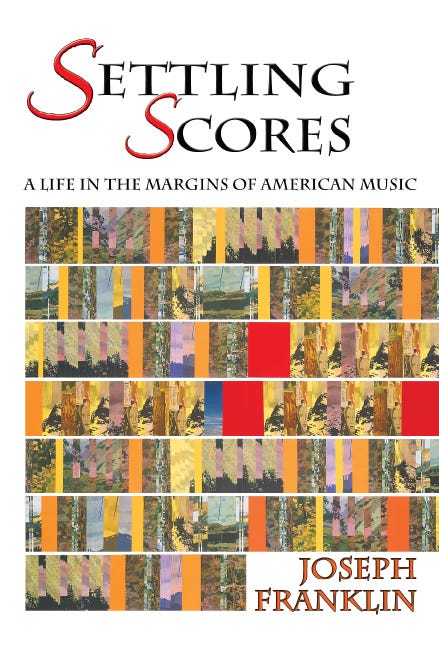October 10, 1987 NMA Philadelphia day 9
Leif Brush - Joseph Kasinskas - Mary Jane Leach - Warren Burt - Susan Stegner - David Mahler - Stuart Dempster - Relâche - Philip Corner - Bruce Mather - ROVA Saxophone Quartet - Roger Reynolds
Saturday October 10, 1987 New Music America Philadelphia
New Music Alliance Meeting: Electing New Board Members
Leif Brush: Connecting Surface Waves: The Terrain Broadcasts
Joseph Kasinskas: Echoes in PalindromesSusan Stenger: The Structures of Everyday Life
Mary Jane Leach: 4BC for four bass clarinetists
Susan Stenger: The Structures of Everyday Life
Warren Burt – Homage to Duchamp - a work for 41 treble tuning forks in a room with marble floors and hard tall walls. Ow. Canines will be escorted from the room prior to performance.
Stuart Dempster – David Mahler: Dempster’s Fantasy on an American Theme
Relâche - Philip Corner: Two French Tritone Dominants
Bruce Mather: Poème du délire, for three pianos, two microtonal.
ROVA Saxophone Quartet: The Unquestioned Answer (For Charles Ives)
Roger Reynolds: The Palace (Voicespace IV)
============================================
New Music Alliance Meeting - Electing New Board Members
(transcription will appear in a future substack, I promise! - gd)
Part 1
Part 2
Part 3
♪
Leif Brush: Connecting Surface Waves: The Terrain Broadcasts
Interactive performance using solar-powered FM transmitters throughout Fairmount Park, the largest city park in America.
♪
Joseph Kasinskas: Echoes in Palindromes
Susan Stenger: The Structures of Everyday Life
Susan Stenger’s sound installation from 2012 bearing the same name but new meanings
https://www.flickr.com/photos/av_festival/8250349590/
And she talks about this particular iteration in this video:
♪
Mary Jane Leach: 4BC for four bass clarinetists
4BC (1984) is for four bass clarinets playing in a small range (a fifth) emphasizing the third partial. It is written for the partials as well as the fundamentals, creating combination and difference tones. … [4BC] was the code I used on the manuscript, and I decided it sounded a little primordial, so I used it for the title.
- Mary Jane Leach, y2b liner notes
♪
Mary Jane and Phill Niblock and Stewart Boesalager and I that afternoon, walking around Fairmount Park trying to get a clear capture of Leif Brush’s FM broadcast from the trunk of a tree:
Mary Jane in a 2015 interview with Frank Oteri and Molly Sheridan of NewMusicBox (I don’t think they have spaces):
♪
Warren Burt – Homage to Duchamp
At the event, I bought from Warren a cassette titled Music for Tuning Forks; although none of the three tracks have the title Homage to Duchamp, the first piece still left my both my memory vibrating; on the one hand he didn’t record this in a place with marble floors and hard walls; on the other hand, we didn’t get to hear him play tuning forks with an accordion and choir.
Improvisation in Two Ancient Modes (1987) (10:00)
Voices, Tuning Forks and Accordion (1986) (19:00); Astra Choir, John McCaughey, conductor, Catherine Schieve microtonal accordion solo
Almond Bread Harmonies (1985); Ernie Althoff, Rodney Berry, Angela Dillon, Robert Paredes, Catherine Schieve, tuning forks; Warren Burt, conductor
Oh! After uploading my copy, here is one probably made with a better transfer system and since it’s on you tube, you can easily bring it with you for your next car pool ride!
*
In an outrageously grand building in the middle of Philadelphia's Fairmount Park, a bearded, long-haired man in a sweatshirt struck a set of amplified tuning forks with a mallet. Ping, ping, went the forks, and sometimes PING, when he waved a big tuning fork, causing the big fork to vibrate sympathetically with the other forks.
This went on for 20 minutes last Saturday afternoon, giving me time to reflect.
I thought about many things, including why New Music America '87, the festival that sponsored the event, hadn't provided a map or at least directions to this place, resulting in a $15 cab fare as the cabbie drove around the largest city park in the world, in search of Memorial Hall.
Mainly, I thought about new music. What is it? Is it even music?
…Maybe there's a good reason the audiences at this, a national festival, tended to number about 100 people.
Maybe the reason most people don't listen to new music is that it is not very good. Maybe it's not music.
What is music? (It was a very long afternoon.)
- Roxanne Orgill, North Jersey Record, “A Disconcerting Sampler of New Music”, October 18, 1987
♪
Stuart Dempster – David Mahler:
Dempster’s Fantasy on an American Theme
My recording at a distance of about fifteen minutes worth - it was presented as I remember in a gymnasium where the baseball diamond was diagrammed on the floor.
*
When we accepted David Mahler's proposal for a piece using baseball imagery I suggested that we stage the performance on a baseball diamond in Fairmount Park. Intrigued with the prospect of realizing his work on an actual baseball field and not in an indoor performance space, David agreed although with reservation. After I suggested we have a back-up plan to move the performance indoors in case it rained he felt much better. So did trombonist Stuart Dempster, who would be performing the piece.
Dempster's Fantasy On An American Theme is a collaboration between two close friends, both of whom have used the tape recorder as a musical instrument in the design and realization of a number of musical works. And they are avid baseball fans who often use baseball terminology, strategies and metaphors in their individual and collaborative projects. David and I share backgrounds as players, although my interest in the game has long since diminished, a casualty to the corporate culture that dominates the sport. David on the other hand remains active, playing senior league ball in Seattle where he has resided for 25 years. Unlike me he retains a boyish fascination with baseball, conversing easily about current major league teams and reminiscing about players and teams who excelled in a very different era, before corporate America soiled the game with their selfish promotions and spawned owners
239
with an eye only on the bottom line. I'm not certain how much baseball Stuart Dempster played as a young guy but I am certain that he has followed the game closely over the years and is as knowledgeable about current trends and players as is David. Clearly this shared interest and enthusiasm for baseball gives them insight in creating works based on imagery and a legion of richly embroidered metaphors that no other team sport has created.
The production team for New Music America '87 loved the idea of designing a performance scene at an outdoor venue. Production coordinator David Michael Kenney was especially enthusiastic since he too was a former ball player and current fan, as were several members of his team. In collaboration with the sound engineers they designed a set with speakers placed on each base and behind home plate.
Stuart was to stand on the pitcher's mound with a microphone to record his trombone playing and commenting on the mise en scene before him.
While Stuart was performing David would be recording him on a reel-to-reel tape recorder that would eventually reveal the secret to Stuart's seemingly random noise-to-noise playing. After Stuart finished, David would rotate the tape reels so that the take-up reel becomes the source tape; essentially playing back the material that had been recorded just moments before. What is revealed is the song Take Me Out To The Ballgame. Stuart had just played the song backwards. David is a master at using the reel-to-reel tape recorder as a solo instrument, manipulating the recording speeds, reversing the reels to untangle what appears to be spoken gibberish only to reveal a coherent text. These and other techniques he employs in a number of early performance works which have proved popular at New Music events.
With the set ready and everyone in place we were poised to present Dempster's Fantasy On An American Theme on one of the baseball diamonds at Belmont Plateau in Fairmount Park, the site of the afternoon events. But there was a problem: it was clouding up with a forecast for rain.
After consulting with everyone, David decided we should revert to our back-up plan and move the set indoors in a section of Memorial Hall that was reserved for just this purpose. Although most of us were disappointed, we backed David's decision, fully understanding his concerns. It remained cloudy but did not rain that day.
Wearing an antique baseball cap and grey flannel jersey, Stuart played Dempster's Fantasy On An American Theme on his trombone with just the right amount of virtuosity and foolishness, coaxing natural and extended sounds
240
from the instrument as easily as Hank Aaron used to roll his wrists and propel a baseball over the left field stands in old Connie Mack Stadium in North Philadelphia. And David rotated the reels on the tape recorder with a gleam in his eye and a bemused look on his face that teased the audience just right.
When the tape played back Stuart's trombone singing "Take me out to the ball game, take me out to the crowd..." in muffled yet easily discerned tones everyone laughed, knowingly of course. It was a great piece but just think how it might have been if it had been played outside on the diamond. Hank would have approved.
- Joseph Franklin Scribing Sound
*
David Mahler's baseball piece combined the national anthem with Take Me Out to the Ball Game to hilarious effect, as trombonist Stuart Dempster made his way around a diamond.
- Kyle Gann, "Quiet Heroics", Village Voice, November 10, 1987
♪
Relâche - Philip Corner: Two French Tritone Dominants
Joseph Franklin: The next piece in the program is another work for piano and ensemble by Phil Corner. The reason I think that Phil Corner’s Two French Tritone Dominants / Berlioz, fits – he’s kind of a bridge between Cage and then the improvisations of [Byard] and others, you’ve got a guy who’ll say, okay, let’s look at this historical moment, what in the world is an augmented sixth chord really for?
Is it an invention of composers from baroque into romantic that essentially worked the same way as a dominant seventh chord with alteration?
29:07 ● It’s interesting, that piece, the Two Tritone Dominants, like it’s a wonderful alternation between the two. With a tritone, you – you have these two entities that are, are going back and forth, they’re – they’re two kind of polar things. That alternation is amazing with the keyboard and ah, he structured the piece where instruments are commenting on one part of the alternation or the other.
Individually, those things want to go somewhere, but with the two of them, they work some kind of tonal balance. It’s a different approach to ah, a tritone.
29:41 Joseph Franklin: It’s not made for the Relâche Ensemble, but it fit their thinking very well, because it provided the pianist – in this case, Phil was the pianist of this – so we supported him. It was notated in traditional notation but it was set up in, in kind of modules where each instrument had a phrase or a motif to play that was fitted over at their choice. Over the piano, since the ostinato that was playing, in which you could hear the augmented sixth chord, ad infinitum, right?
Phil was a prominent member of the Downtown new music scene in the, in the sixties, fifties, sixties into the seventies. He was a member of the um, Judson Dance Theatre. Along with James Tenney, Malcolm Goldstein and others, he created a lot of music for the experimental choreographers of the Judson Dance Theatre. So let’s listen to Phil Corner’s work, Two French Tritone Dominants, Berlioz. And there are two of these that he’s performed, we’re selecting the first one, which is kind of subtitled Berlioz.
- Joseph Franklin, The Relâche Chronicles: New Music America
♪
Bruce Mather: Poème du délire, for three pianos, two microtonaled
♪
ROVA Saxophone Quartet: The Unquestioned Answer (For Charles Ives)
*
The ROVA Saxophone Quartet too, did their usual genre-defying miracles in The Questioned Answer, a carefully honed improv structure whose lucidity equaled its virtuosity. The moment when the music paused for Jon Raskin to play a fateful quotation from Ives's The Unanswered Question was my candidate for most magical moment of the week.
- Kyle Gann, "Quiet Heroics", Village Voice, November 10, 1987
♪
Roger Reynolds: The Palace (Voicespace IV)
Posted by “Spiral Agnew”
=================================
https://www.relache.org/podcast/episode/7aa5f05a/new-music-america-1987-philadelphia








